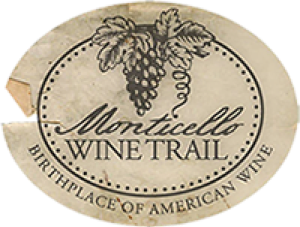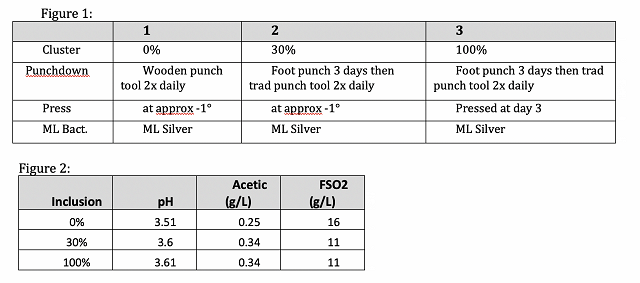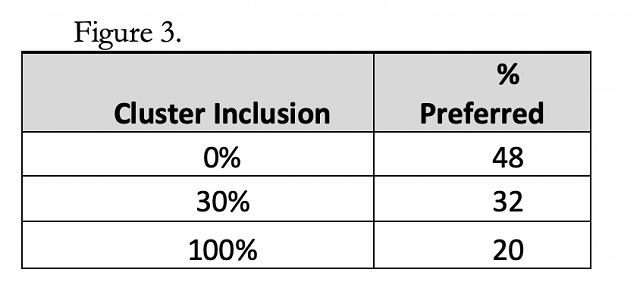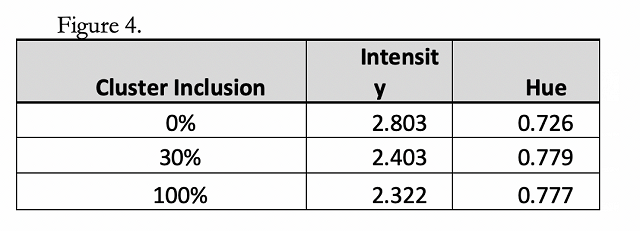Whole Cluster Inclusion of Cabernet Franc (2014)
Kirsty Harmon
Blenheim Vineyards

Abstract
Purpose: Assess sensory attributes of different percentages of whole cluster inclusion of Cabernet Franc fermentations utilizing 3 unique protocols. Methods: Two tons of cab franc with identical sourcing were harvested and separated into three equal amounts (wt.). A unique protocol was applied to each t-bin and after pressing transferred to identical Seguin Moreau CP M+ 2008 barrels. Each barrel inoculated with ML Silver, upon completion of MLF, 5.2g/hL SO2 added. Results: Sensory evaluation showed a strong preference for the 0% and 30% inclusion groups over the 100%. Color analysis reveals a decline in intensity as whole cluster percentages increase. Discussion: Future experimentation may include smaller percentages of cluster inclusion or different methods of integration. Conclusion: Whole cluster inclusion on Cab Franc has a detectable sensory effect on the finished wine.
Presented Jan 28, 2015 at Trump Vineyards
Keywords: Cab Franc, whole cluster, color intensity
Whole Cluster Inclusion of Cab Franc
Purpose
Assess sensory attributes of different percentages of whole cluster inclusion of Cabernet Franc fermentations utilizing 3 unique protocols.
Methods
Two tons of Cab Franc from the same vineyard area were harvested on the same day. The grapes were chilled overnight and then separated into three equal amounts by weight. For each lot a certain percentage of the cab franc remained as whole cluster and the remaining percentage was de-stemmed, but not crushed. The first t-bin was 0% whole cluster, the second was 30% whole cluster, and the third was 100% whole cluster. A unique treatment protocol was then applied to each t-bin (Figure 1). After pressing, the wine was transferred to identical Seguin Moreau CP M+ 2008 barrels. Upon transfer each barrel was inoculated with ML Silver; at completion of MLF, 5.2g/hL SO2 added. Laboratory analysis was performed on the wine (Figure 2).

Results
Sensory evaluation showed a strong preference for the 0% inclusion group over the 100% inclusion group (Figure 3). Additionally, there was a small preference for the 30% inclusion group over the 100%. There was a greater preference for the 0% inclusion than the 30% but statistical significance of this preference cannot be determined with the current sampling size.

Color analysis reveals a logarithmic decline in intensity inversely proportional to the increase in whole cluster inclusion (r2 = 0.998)(Figure 4). Hue is relatively stable between the three groups, but as the inclusion percentage increases the intensity of the resultant wine decreases. This could be caused by a increase in the amount of stems in the respective lots not contributing to intensity in the way that an equal weight of additional grapes may.

Descriptive sensory analysis collected from participants of the research exchange (Appendix A), as provided, shows no clear preferences. Descriptors used for one wine are often the same as descriptors used for the wines. Also, in many cases, descriptors of the same wine will be contradictory to one another. This makes gleaning information difficult, however some general patterns do come out. In the 100% whole cluster group, the taste is generally described as being the most intense and as having more of a savory flavor. Conversely, the 30% and 0% inclusion groups are often described as having more fruit than the 100% but also having a lighter body.
Descriptive analysis provided by Enartis
Lab values (Figure 2) indicate higher pH and acetic acid levels in the 30% and 100% as compared to the 0%. This may be a result of the increased FSO2 in the 0% group, however, with grapes already at risk for having high VA, whole cluster inclusion may be risky.
Discussion
This experiment was performed in an attempt add “tannin” and mouth-feel to Cab Franc wine by using whole clusters in lieu of adding enological tannin. Sensory data shows that there were appreciable differences between the three protocols.
Descriptive analysis and preference data showed a tendency away from the 100% whole cluster fraction, but also a large preference for the 30% inclusion fraction. Given this, a plausible route for future research would be exploring the sensory aspect of wines with amounts of whole cluster inclusion between 0 and 30%. To this same end, future triangle experimentation will be important in defining the ideal range for whole cluster inclusion and a what level it stop altering the taste of the finished wine. Though whole cluster inclusion shows a promising way to help eliminate additives without sacrificing flavor, it is important to note potential drawbacks.
Color analysis shows a drop in intensity as the percentage of whole cluster increases. Though perhaps not a significant difference with whole cluster inclusion, it will be important to understand how these numbers change over time i.e. the effect of whole cluster inclusion on color stability. Enological tannin added before fermentation will generally increase the color stability of the resultant wine over time. It seems reasonable to assume the intensity variations seen between these three groups, is due to a diluent effect. However, follow up color analysis will be needed to determine how whole cluster inclusion effects color stability.
Comment on lab values that we get back from Enartis
Comment on sensory info from Enartis
Conclusion
Whole cluster inclusion during fermentation of Cab Franc has a significant impact on the sensory attributes of the finished wine. It shows itself as a potential method for naturally enhanced flavor and mouth-feel. Methodological concerns include unknown effects on color stability and acetic acid levels.
References
http://www.wineanorak.com/wholebunch.htm
https://wineopeners.wordpress.com/2014/08/23/hands-off-the-role-of-whole-cluster-fermentation/
Appendix A – Descriptive Sensory Analysis Data
Blenheim Whole Cluster
0%
Aroma: Strawberry, earthy (2), red fruit (3), eucalyptus, cherry (5), not as much red fruit, light+fruit, black current (2), “vegebal”, less oak, raw woodiness, stemmy, nice, expressive, fresh green pea, sawdust, slight rubber, raspberry, mint, more intense flavor, clove, clean, white pepper, toast, Kirsch, lightly herbaceous, black pepper, brighter nose, lower spice than others, musky/off, cherry, minerality, reductive, slightly cherry, sulfur (2), metallic, less fruit, ripest
Taste: more astringent finish, balanced acid, more tannic, more bell pepper, good weight, soft mouth feel, dusty, short, firm tannin, lean, woody, earthy, pleasantly bitter, decent mouth feel (2), more tannin, light (2), bland, fresh red fruit (2), pepper, “racey”, black cherry, watered down?, no mid-palette, soft, plush, tacky tannins, great balance, long finish, some bitterness, medium body, cherry, green not as prominent as other two, less earthy, less body,
30%
Aroma: slight reduction (2), dark red fruit (2), jammy, spice, earth (2), pepper (2), herbaceous (2), bright, vibrant cherry, dusty, richer than the rest, plum, cranberry, mint, liquorish, raisins, least aromatic (2), jammy, petro, sulfur, oak, slightly burnt, more fruit integration, best aroma, cherry lifesaver, ethanol comes through (2), stemmy, black cherry, vanilla, warm, cherry, muted cherry, cranberry cinnamon, bright acidity, less aromatic, bit astringent
Taste: bitter finish, low pH, stemmy, bright cherry, flat (2), red cherry, short finish, low acid, clean, fresh, balanced acid, lean, nutty, vegetal, not bad, light acid, less mouth feel, light flavor of mossberry, touch of green, less fruit, getting alcohol burn, disappears up front. Soft, broad, sweet, balanced, lighter, smoother, more volume than 0%, nice, great acidity w/ the tannins, thin/short acid, cherry, slightly burnt, best mouth feel, cranberry, methoxypyrazines dominant in front, black pepper, medium body, higher acidity, cherries with tart finish
100%
Aroma: slight reduction (2), red fruit, cherry (3), floral, less pronounced, red fruit still good, rich, dusty, “vegebal”, herbal (2), strawberry, pine, sulfur, chemical, mineral, muted, some fruit, rubber/latex, coca, gamey (2), animal fur, fruity, green, light, spicy, pepper (2), warm, musty, veggie, vanilla, plastic, earth, ripe dark fruits, cigar box, somewhat green finish, spice, juicy fruit, cranberry, cherry jolly rancher, best balance
Taste: Bitter finish, greenish/vegetal, smoothest, soft tannins, good fruit, low acid, slight oak, firm tannin, strawberry, muted, short, reductive, best structure, light body and acid, black olive, tea, savory, little stinky, good tannins, most balance, like the fruit integration, softer& broader than 0%, good for aging but slightly astringent, linear, acidic, big tannins slightly over powering. Fuller body, good tannins, more complex, most intensity, light, tart but round, medium body, medium-high acidity, best mouth feel.
